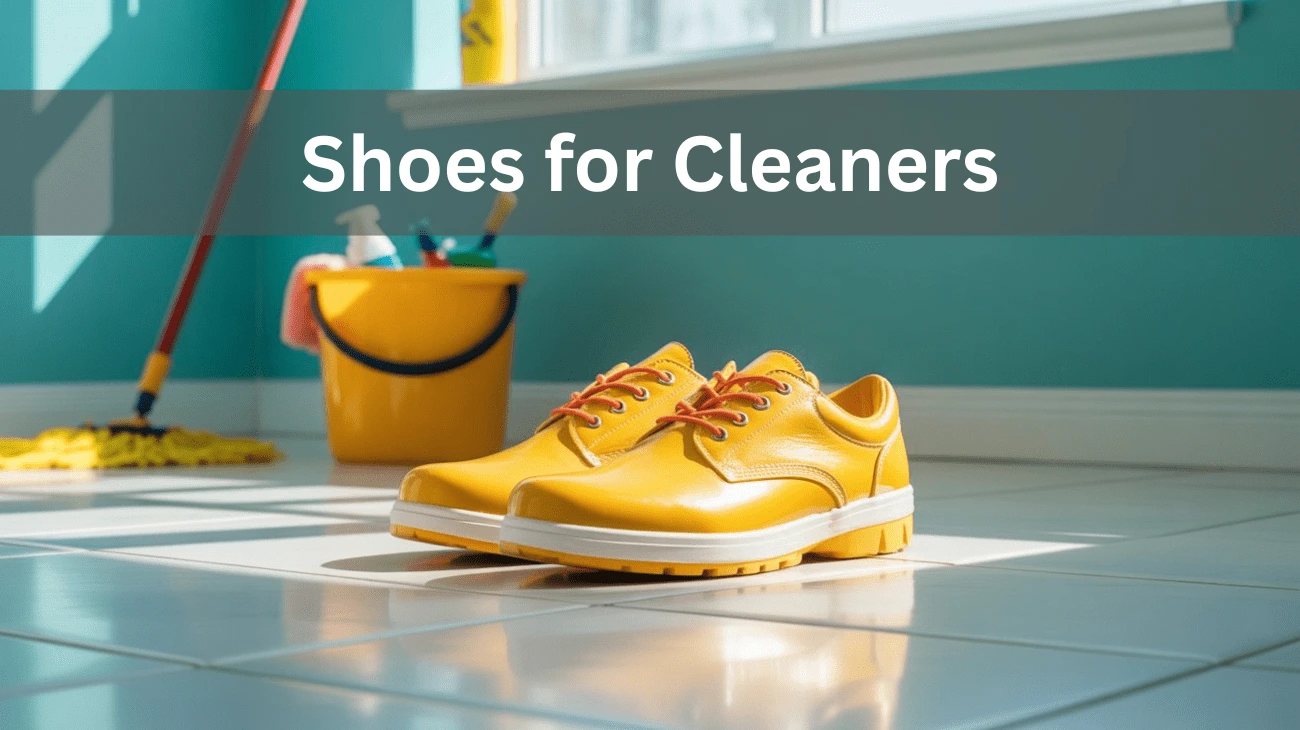Cleaners are the backbone of hygiene in every environment—from homes and offices to hospitals and schools. Their work is demanding, both physically and mentally, requiring them to spend long hours on their feet. That’s why selecting the right shoes for cleaners is more than a footwear choice—it’s about safety, support, and productivity.
This guide offers everything you need to know about choosing shoes built specifically for cleaning professionals, including benefits, challenges, features to look for, and buying tips tailored to your working conditions.
What Are Shoes for Cleaners?
Shoes for cleaners are occupational footwear specifically designed to handle the rigorous demands of cleaning jobs. These shoes are built with anti-slip soles, cushioning for comfort, support for long hours, and materials that can withstand wet, slippery, and chemically exposed environments.
Unlike regular sneakers or casual shoes, they meet workplace safety standards and offer functionality that directly supports cleaner productivity and health.
Why the Right Shoes Matter in the Cleaning Industry
Wearing the wrong shoes during cleaning shifts can have serious consequences. Water, cleaning agents, and hard surfaces frequently expose cleaners, thereby increasing the risk of slips, injuries, and fatigue. Proper footwear reduces the chances of work-related accidents, supports posture, and boosts overall comfort.
The right shoes contribute to better foot health, which is directly linked to reduced absenteeism and improved job performance. They also offer peace of mind by helping professionals move quickly and confidently in potentially hazardous work environments.
Key Benefits of High-Quality Cleaning Shoes
Choosing the best shoes for your cleaning job offers a wide range of benefits that go beyond simple comfort:
- Slip Resistance: Cleaning surfaces are often wet or greasy. Non-slip soles protect against falls.
- All-Day Comfort: Good insoles reduce strain, keeping your feet fresh even during 10+ hour shifts.
Aside from these, durable materials ensure longer use, saving money in the long run. Many cleaning shoes also feature arch and heel support, which helps prevent common workplace injuries such as plantar fasciitis and lower back pain.
Additionally, water-resistant shoes keep your feet dry, while easy-to-clean surfaces prevent bacteria buildup. This is particularly essential in environments like hospitals or restaurants, where hygiene standards are critical.
Common Footwear Challenges Faced by Cleaners
One of the biggest issues cleaners face is wearing shoes that are not fit for the job. Casual sneakers or worn-out work boots may not offer adequate grip or cushioning. Over time, such footwear can lead to joint pain, fatigue, and even chronic foot conditions.
In some cases, poor shoe design leads to slipping, especially on wet tile or linoleum surfaces. Many cleaners also report that their shoes wear out quickly due to exposure to harsh cleaning chemicals. Finding shoes that balance cost, comfort, durability, and appearance is a frequent struggle in the profession.
Who Needs Cleaning Shoes?
Shoes for cleaners aren’t one-size-fits-all. They serve a variety of roles across multiple industries.
Hospital janitors, for example, need shoes that resist fluid penetration and are easy to disinfect. Hotel housekeeping staff require lightweight shoes that support constant movement. Industrial cleaners, on the other hand, may need reinforced soles and chemical-resistant materials for extra protection.
Residential cleaners and part-time workers also benefit from proper footwear that minimizes fatigue and enhances movement flexibility.
Top Features to Look for in Shoes for Cleaners
When shopping for shoes, focus on the features that directly impact your comfort and safety on the job. Quality work shoes include:
- Slip-resistant outsoles made of durable rubber
- Cushioned insoles with memory foam or gel padding
In addition to these, seek shoes with breathable uppers that reduce sweating, water-resistant coatings for damp conditions, and shock-absorbing midsoles to ease joint stress. Closed-toe protection is also important for shielding your feet from dropped tools or cleaning equipment.
Look for lightweight construction, especially if your job involves walking or climbing stairs. Lastly, pick a pair with easy maintenance—something you can wipe clean quickly after a shift.
Step-by-Step Guide: How to Choose the Best Shoes for Cleaning Jobs
Step 1: Assess Your Work Conditions
Consider where you’ll be working. Wet environments, chemical exposure, or standing for hours all call for specific Shoes for Cleaners features like waterproofing or added cushioning.
Step 2: Set a Reasonable Budget
High-quality work shoes usually range from $50 to $150. View the purchase as a long-term investment in your health and efficiency rather than an expense.
Step 3: Prioritize Fit and Comfort
Try on shoes later in the day when your feet are slightly swollen, as this reflects your typical working condition. Ensure a snug heel fit and enough toe room to prevent rubbing or blisters.
Step 4: Look for Safety Certifications
Shoes meeting ASTM, OSHA, or similar standards are ideal, especially in industrial or medical cleaning roles.
Step 5: Check Customer Reviews
Feedback from fellow cleaners reveals how shoes perform over time, especially in areas like grip, support, and durability.
Step 6: Maintain Your Shoes
Keep them clean, replace worn insoles, and rotate between two pairs if possible. This prolongs the life of your footwear and improves hygiene.
Recommended Brand Shoes for Cleaners
Several trusted brands offer top-rated shoes tailored to cleaning professionals:
Skechers Work: Known for their slip-resistant soles and memory foam comfort, these shoes are affordable and widely available.
Crocs On-the-Clock & Bistro Series: Ideal for wet environments, these waterproof, easy-to-clean clogs are popular in healthcare and food service settings.
Shoes for Crews: A leading brand in occupational footwear, offering various designs with industry-leading slip resistance.
Dansko Professional Clogs: These offer excellent arch support and comfort for long shifts and are commonly used by healthcare cleaners.
New Balance Slip Resistant Work Shoes: Athletic style combined with workplace durability makes them ideal for cleaners in active environments.
Final Thoughts:
If you’re a cleaner, your shoes are your most important work tool. The right pair can reduce fatigue, prevent injury, and make your workday more efficient and enjoyable. Investing in shoes designed for cleaners is not just smart—it’s essential.
Take action today. Find a pair that matches your job’s demands, protects your health, and helps you do your best work every step of the way.
Read More About Lifestyle: https://deepworldinsights.com/category/lifestyle/
FAQs About Shoes for Cleaners
What are the most important features in cleaning shoes?
Slip resistance, cushioning, waterproofing, and arch support are essential features to look for in quality cleaning shoes.
Can I wear running shoes for cleaning work?
Not all running shoes are suitable. Only use them if they have non-slip soles, water resistance, and offer long-lasting comfort.
How often should I replace my cleaning shoes?
Typically, you should replace your cleaning shoes every 6 to 12 months, depending on your usage and level of wear. Signs of wear include loss of grip, sole compression, and torn fabric.
Do I need waterproof shoes for indoor cleaning jobs?
Yes, even indoor jobs may involve exposure to water or cleaning solutions. Waterproof shoes help keep your feet dry and safe.
Are steel-toe shoes required for cleaners?
Steel-toe shoes are exclusively necessary in industrial settings. Most residential or commercial cleaners can opt for lightweight, non-steel-toe shoes that still provide protection.


